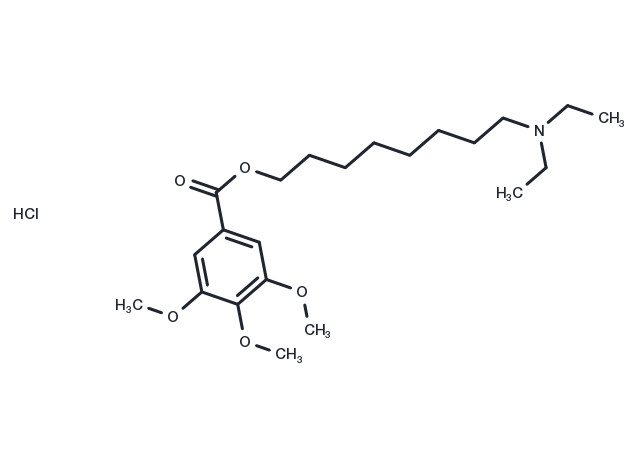Powder: -20°C for 3 years | In solvent: -80°C for 1 year


TMB 8 is a non-competitive antagonist of nicotinic acetylcholine receptors (nAChRs) with IC50 values of 390 and 350 nM, respectively, for human muscle-type and α3β4 subunit-containing ganglionic nAChRs expressed in TE671/RD or SH-SY5Y cells. It inhibits nicotine-induced dopamine release from rat brain synaptosomes (IC50 = 480 nM). TMB 8 also reduces calcium availability in smooth and skeletal muscle, blocking the contractile response in isolated rabbit aortic strip when used at a concentration of 50 μM and inhibiting calcium influx and efflux in isolated guinea pig ileum when used at a concentration of 65 μM. It has been used in the study of intracellular calcium dynamics, particularly in smooth muscle. TMB 8 also inhibits protein kinase C (PKC) activity in a dose-dependent manner.

| Pack Size | Availability | Price/USD | Quantity |
|---|---|---|---|
| 5 mg | 35 days | $ 68.00 | |
| 10 mg | 35 days | $ 125.00 |
| Description | TMB 8 is a non-competitive antagonist of nicotinic acetylcholine receptors (nAChRs) with IC50 values of 390 and 350 nM, respectively, for human muscle-type and α3β4 subunit-containing ganglionic nAChRs expressed in TE671/RD or SH-SY5Y cells. It inhibits nicotine-induced dopamine release from rat brain synaptosomes (IC50 = 480 nM). TMB 8 also reduces calcium availability in smooth and skeletal muscle, blocking the contractile response in isolated rabbit aortic strip when used at a concentration of 50 μM and inhibiting calcium influx and efflux in isolated guinea pig ileum when used at a concentration of 65 μM. It has been used in the study of intracellular calcium dynamics, particularly in smooth muscle. TMB 8 also inhibits protein kinase C (PKC) activity in a dose-dependent manner. |
| Molecular Weight | 431.99 |
| Formula | C22H38ClNO5 |
| CAS No. | 53464-72-5 |
Powder: -20°C for 3 years | In solvent: -80°C for 1 year
Methanol: Slightly soluble
H2O: Slightly soluble
Chloroform: Slightly soluble
You can also refer to dose conversion for different animals. More
bottom
Please see Inhibitor Handling Instructions for more frequently ask questions. Topics include: how to prepare stock solutions, how to store products, and cautions on cell-based assays & animal experiments, etc.
TMB 8 (hydrochloride) 53464-72-5 TMB-8 TMB 8 TMB8 inhibitor inhibit
